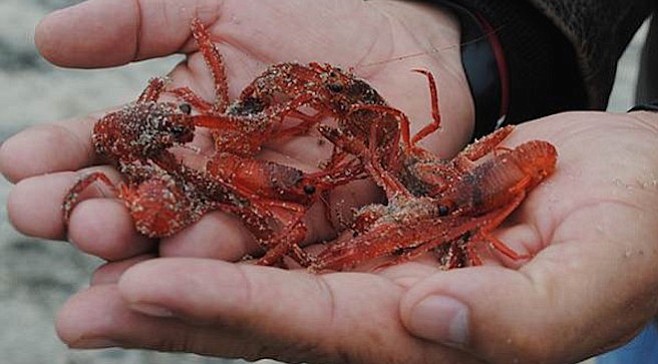 Facebook
Facebook
 X
X
 Instagram
Instagram
 TikTok
TikTok
 Youtube
Youtube

Thousands of baby pelagic red crabs have washed up on the beaches of Playas de Tijuana, the latest in a series of odd occurrences along the shores of Baja California that have left marine biologists baffled.
Some crabs began washing ashore early Monday morning, May 25, but the phenomenon was much more noticeable on Tuesday, May 26, residents of the area told the daily newspaper El Sol de Tijuana.
In some areas, there were so many of the creatures that they “painted the sand red,” the newspaper reported.
Just a few days ago, according to El Sol, hundreds of jellyfish washed up on the beaches; within the past week, three dead whales and a deceased sea lion were discovered along the same shoreline.
So far, marine biologists have been unable to explain the cause of the peculiar events, the newspaper reported, though some have suggested it could be related to El Niño, a cyclical weather pattern originating off the Pacific coast of South America.
Authorities recruited residents of La Perla and El Vigía neighborhoods of Playas to help return as many of the baby crabs as possible to the water.
Several dozen neighbors turned out to help and worked for hours to return the tiny creatures to the sea, El Sol reported. The crabs measured just 5 to 7 centimeters long (about 2–3 inches), and were already being devoured by seagulls and ants.


Thousands of baby pelagic red crabs have washed up on the beaches of Playas de Tijuana, the latest in a series of odd occurrences along the shores of Baja California that have left marine biologists baffled.
Some crabs began washing ashore early Monday morning, May 25, but the phenomenon was much more noticeable on Tuesday, May 26, residents of the area told the daily newspaper El Sol de Tijuana.
In some areas, there were so many of the creatures that they “painted the sand red,” the newspaper reported.
Just a few days ago, according to El Sol, hundreds of jellyfish washed up on the beaches; within the past week, three dead whales and a deceased sea lion were discovered along the same shoreline.
So far, marine biologists have been unable to explain the cause of the peculiar events, the newspaper reported, though some have suggested it could be related to El Niño, a cyclical weather pattern originating off the Pacific coast of South America.
Authorities recruited residents of La Perla and El Vigía neighborhoods of Playas to help return as many of the baby crabs as possible to the water.
Several dozen neighbors turned out to help and worked for hours to return the tiny creatures to the sea, El Sol reported. The crabs measured just 5 to 7 centimeters long (about 2–3 inches), and were already being devoured by seagulls and ants.
Comments